Solar eclipse of August 21, 1933
An annular solar eclipse took place on Monday, 21 August 1933. A solar eclipse occurs when the Moon passes between Earth and the Sun, thereby totally or partly obscuring the image of the Sun for a viewer on Earth. An annular solar eclipse occurs when the Moon's apparent diameter is smaller than the Sun's, blocking most of the Sun's light and causing the Sun to look like an annulus (ring). An annular eclipse appears as a partial eclipse over a region of the Earth thousands of kilometres wide. Annularity was visible from Italian Libya (today's Libya), Egypt, Mandatory Palestine (today's Israel, Palestine and Jordan) including Jerusalem and Amman, French Mandate for Syria and the Lebanon (the part now belonging to Syria), Iraq including Baghdad, Persia, Afghanistan, British Raj (the parts now belonging to Pakistan, India, Bangladesh and Myanmar), Siam (name changed to Thailand later), Dutch East Indies (today's Indonesia), North Borneo (now belonging to Malaysia), and Australia.
| Solar eclipse of August 21, 1933 | |
|---|---|
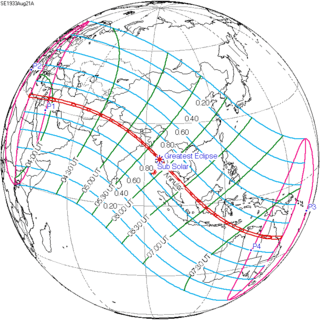 Map | |
| Type of eclipse | |
| Nature | Annular |
| Gamma | 0.0869 |
| Magnitude | 0.9801 |
| Maximum eclipse | |
| Duration | 124 sec (2 m 4 s) |
| Coordinates | 16.9°N 95.9°E |
| Max. width of band | 71 km (44 mi) |
| Times (UTC) | |
| Greatest eclipse | 5:49:11 |
| References | |
| Saros | 134 (39 of 71) |
| Catalog # (SE5000) | 9359 |
Related eclipses
Solar eclipses 1931–1935
This eclipse is a member of a semester series. An eclipse in a semester series of solar eclipses repeats approximately every 177 days and 4 hours (a semester) at alternating nodes of the Moon's orbit.[1]
| Solar eclipse series sets from 1931–1935 | |||||
|---|---|---|---|---|---|
| Descending node | Ascending node | ||||
| 114 | September 12, 1931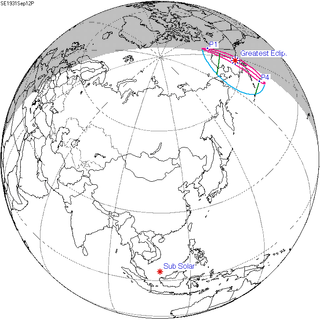 Partial |
119 | March 7, 1932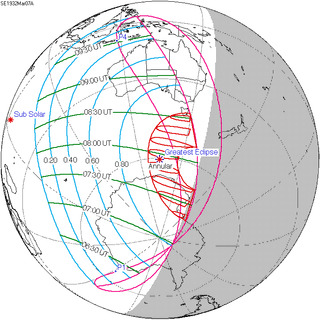 Annular | ||
| 124 | August 31, 1932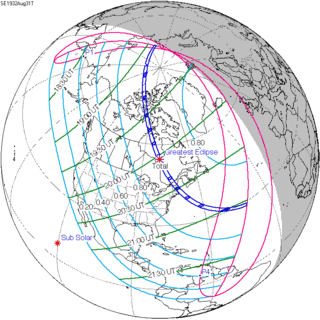 Total |
129 | February 24, 1933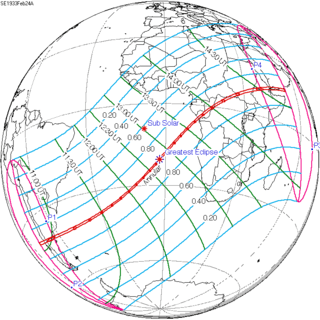 Annular | ||
| 134 | August 21, 1933 Annular |
139 | February 14, 1934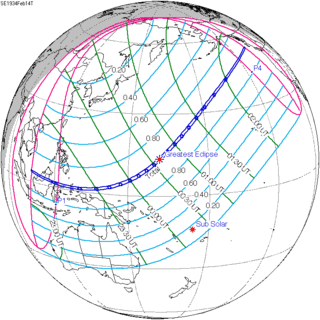 Total | ||
| 144 | August 10, 1934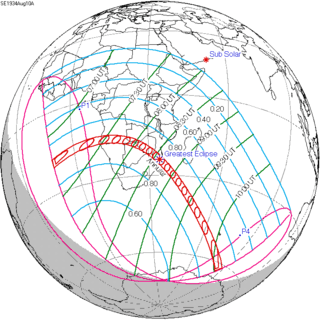 Annular |
149 | February 3, 1935 Partial | ||
| 154 | July 30, 1935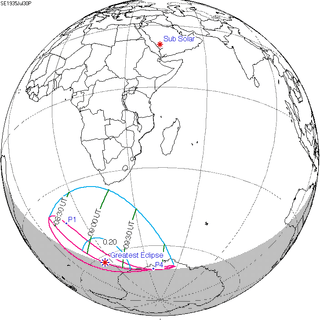 Partial | ||||
Saros 134
It is a part of Saros cycle 134, repeating every 18 years, 11 days, containing 71 events. The series started with partial solar eclipse on June 22, 1248. It contains total eclipses from October 9, 1428 through December 24, 1554 and hybrid eclipses from January 3, 1573 through June 27, 1843, and annular eclipses from July 8, 1861 through May 21, 2384. The series ends at member 71 as a partial eclipse on August 6, 2510. The longest duration of totality was 1 minutes, 30 seconds on October 9, 1428. All eclipses in this series occurs at the Moon’s descending node.[2]
| Series members 32–48 occur between 1801 and 2100: | ||
|---|---|---|
| 32 | 33 | 34 |
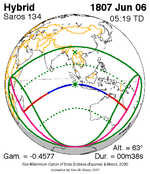 June 6, 1807 |
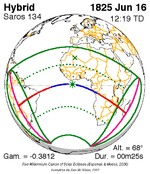 June 16, 1825 |
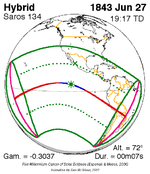 June 27, 1843 |
| 35 | 36 | 37 |
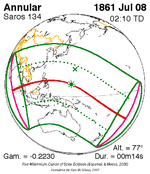 July 8, 1861 |
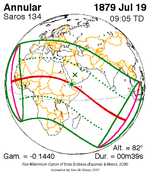 July 19, 1879 |
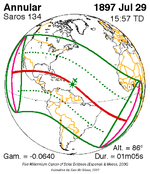 July 29, 1897 |
| 38 | 39 | 40 |
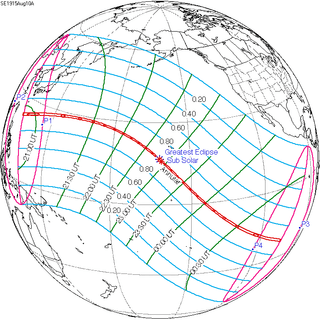 August 10, 1915 |
 August 21, 1933 |
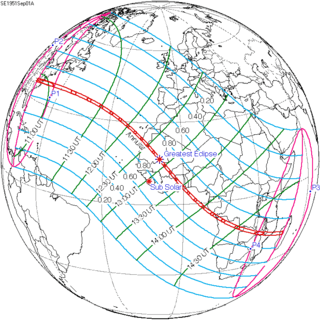 September 1, 1951 |
| 41 | 42 | 43 |
 September 11, 1969 |
 September 23, 1987 |
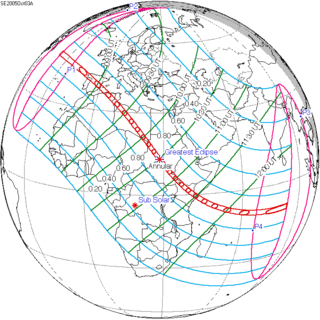 October 3, 2005 |
| 44 | 45 | 46 |
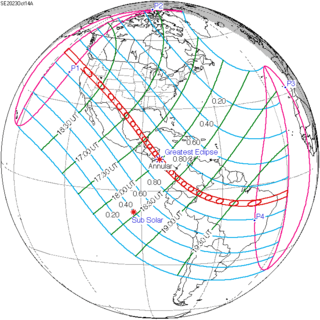 October 14, 2023 |
 October 25, 2041 |
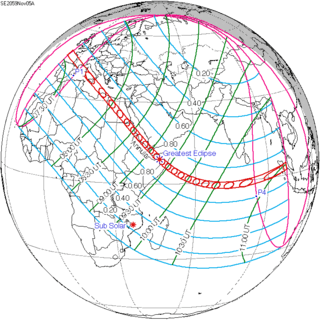 November 5, 2059 |
| 47 | 48 | |
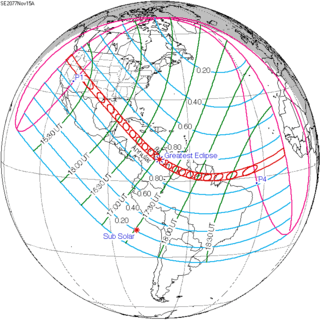 November 15, 2077 |
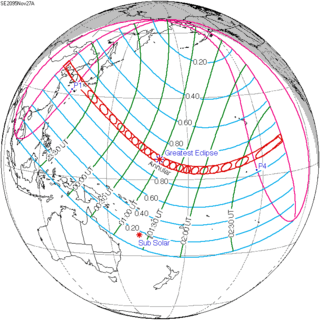 November 27, 2095 | |
Inex series
This eclipse is a part of the long period inex cycle, repeating at alternating nodes, every 358 synodic months (≈ 10,571.95 days, or 29 years minus 20 days). Their appearance and longitude are irregular due to a lack of synchronization with the anomalistic month (period of perigee). However, groupings of 3 inex cycles (≈ 87 years minus 2 months) comes close (≈ 1,151.02 anomalistic months), so eclipses are similar in these groupings. In the 18th century:
- Solar Saros 127: Total Solar Eclipse of 1731 Jan 08
- Solar Saros 128: Annular Solar Eclipse of 1759 Dec 19
- Solar Saros 129: Annular Solar Eclipse of 1788 Nov 27
| Inex series members between 1801 and 2200: | ||
|---|---|---|
| Near lunar perigee | After lunar apogee Before lunar perigee |
Before lunar apogee After lunar perigee |
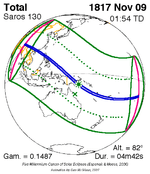 November 9, 1817 (Saros 130) |
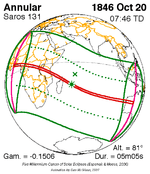 October 20, 1846 (Saros 131) |
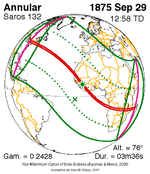 September 29, 1875 (Saros 132) |
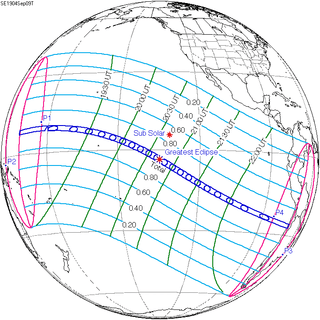 September 9, 1904 (Saros 133) |
 August 21, 1933 (Saros 134) |
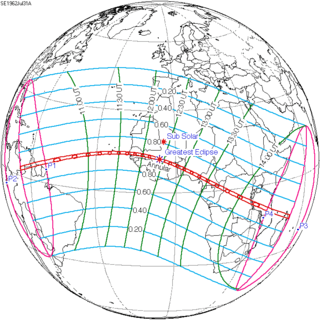 July 31, 1962 (Saros 135) |
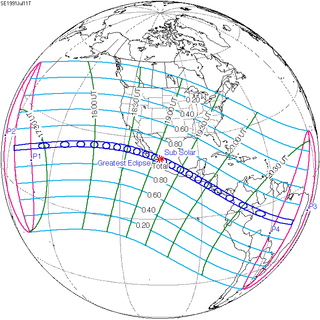 July 11, 1991 (Saros 136) |
 June 21, 2020 (Saros 137) |
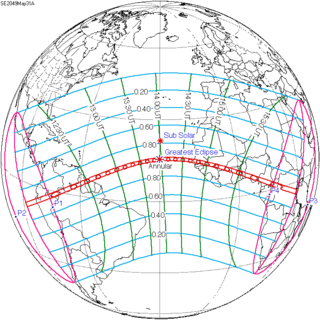 May 31, 2049 (Saros 138) |
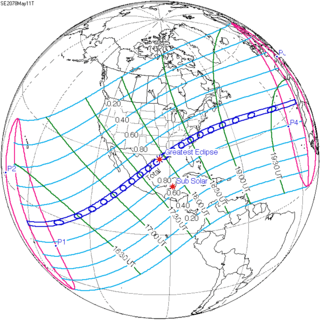 May 11, 2078 (Saros 139) |
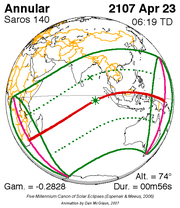 April 23, 2107 (Saros 140) |
 April 1, 2136 (Saros 141) |
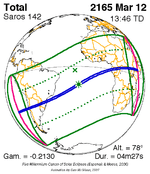 March 12, 2165 (Saros 142) |
 February 21, 2194 (Saros 143) |
|
In the 23rd century:
- Solar Saros 144: Annular Solar Eclipse of 2223 Feb 01
- Solar Saros 145: Total Solar Eclipse of 2252 Jan 12
- Solar Saros 146: Annular Solar Eclipse of 2280 Dec 22
Notes
- van Gent, R.H. "Solar- and Lunar-Eclipse Predictions from Antiquity to the Present". A Catalogue of Eclipse Cycles. Utrecht University. Retrieved 6 October 2018.
- http://eclipse.gsfc.nasa.gov/SEsaros/SEsaros134.html
References
- Earth visibility chart and eclipse statistics Eclipse Predictions by Fred Espenak, NASA/GSFC
.jpg)
